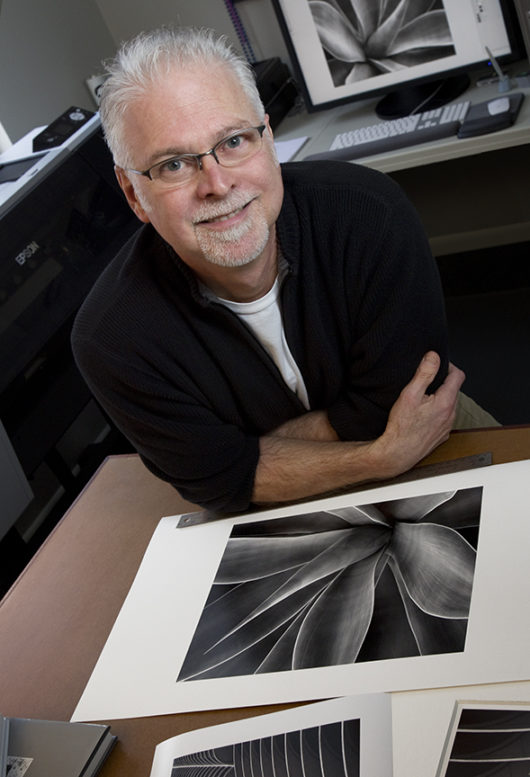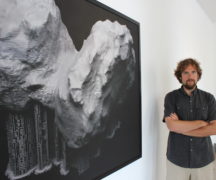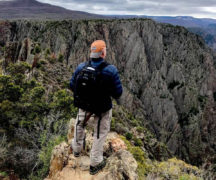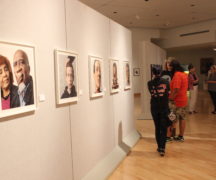By DAVID DUPONT
BG Independent News
Jan Bell’s photographs have a timeless quality. One of the most important ingredients in achieving that sense of chronological suspension is time itself.
When Bell travels to the Great West or the shores of Lake Superior, he takes his time, stays awhile, acclimates himself to his surroundings. And waits on the light.
On a recent two-week trip to the north he spent the better part of two weeks and all he saw were blue skies. He doesn’t like clear day or, rather, he doesn’t like the harsh shadows the sun produces.
So he waits. Luckily, he said, he appreciates the solitude. “Ideally I like to be alone so I have a clear mind to think about what I’m doing. … I don’t get bored. I just enjoy being out there away from people enjoying the wonderful coastline.”
Bell studies what he sees before him, looking for the right combination of shade and texture and shape that makes for a telling composition. And he waits for that soft overcast light that smooths it all out.
When the moment arrives, he shoots long exposures, up to 30 seconds long, tripping his shutter by remote control. “I’m very meticulous as I shoot. I love the process. The world just slows down. The shooting part, that’s the thrill. Then when I get in the darkroom I know what I have to do.”
Back in his studio he refines the look and emotional punch using Photoshop. The result are archival pigment prints, printed on museum grade 100 percent cotton, that make the viewer wonder if the trees, the water and rocks may indeed have souls.
These images have attracted national attention and honors. In January, Bell won a M. Reichmann Luminous Landscape grant. The honor includes publication in LensWork magazine. Also this year he learned that the Toledo Museum of Art had acquired one of his prints for its permanent collection. A print of his photograph “Agave” was donated to the museum by Ann Arbor photographer Howard Bond. The museum then accepted it and added it to its permanent collection.
With those achievements Bell has been able to check off two more items on his list of career goals.
These mark the most recent accomplishments in his mid-life career as an art photographer. In his younger years, Bell, 62, was an avid photographer, but with the demands of family and a job as art director at WBGU-TV, he set his camera aside. A trip with a friend who was a photographer led him to get his camera back out, and he found a new vocation.
The first fruits of his work were exhibited in shows in Bowling Green in 2002 as well as inclusion in Toledo Area Artists Exhibition at the Toledo Museum. He also hit the art fair circuit winning top prizes at the Black Swamp Arts Festival and Crosby Festival of the Arts in his first season. The next year he was accepted into a prominent Chicago art fair.
In 2010 his photograph “Agave” won the grand prize in the Ansel Adams Photo Competition.
That’s the first print Susan Peet, of Bowling Green, purchased for her family. Since then Peet has acquired four more Bell images for herself and her sons, Andrew, James and William. Most recently they visited Bell at his home to select one for her youngest son, William, who just recently graduated from high school.
He selected “Distant Island,” a misty view of a small island on Lake Superior. Bell described the image as “ethereal, dreamy.”
Susan Peet said it captures something about where her son is in life.
For herself she selected a photograph of “Joshua Tree.” Previously she had purchased “Yellowstone Trees.” She’d been to Yellowstone, and seen the trees. She was captivated by the way Bell captured them. “It looks like the barks are illuminated.”
That effect is what drew her to his work when she first learned about Bell from a story about his winning the Ansel Adams Award. She likes to support local artists, so she checked out his website and then visited him.
As “a wannabe photographer” she found his work “stunning,” she said. “His eye and attention to detail was very impressive to me.”
Bell’s work has moved more and more in the direction of art photography. That means taking series of related photographs. Bell prints mostly in black and white. He has since 2006 when he attended a workshop at the Ansel Adams Gallery in Yosemite.
“A lot of color shots to me look like postcards,” he said. Still “there are certain subjects that require the color to give the wow factor.” The Mesa Arch in Canyonlands National Park in Utah “needs color,” he said.
Bell still needs to produce some color work for sale at art fairs. “There’s a strange dichotomy here,” he said. “Doing art shows, there has to be a little of everything to appeal to the masses.” But curators in the art world “like to see bodies of work,” he said. “It’s a juggling act.” A necessity for now, especially since he retired from WBGU. The art fair sales support his art work. “Artists can’t rely on grants.”
Bell will put the money from the Reichmann grant to fitting use. It will go to support a trip up the coast of Oregon and Washington, another journey in search of the right combination of light, texture and vision.
To view Jan Bell’s work, visit: http://www.bellimages.com/





